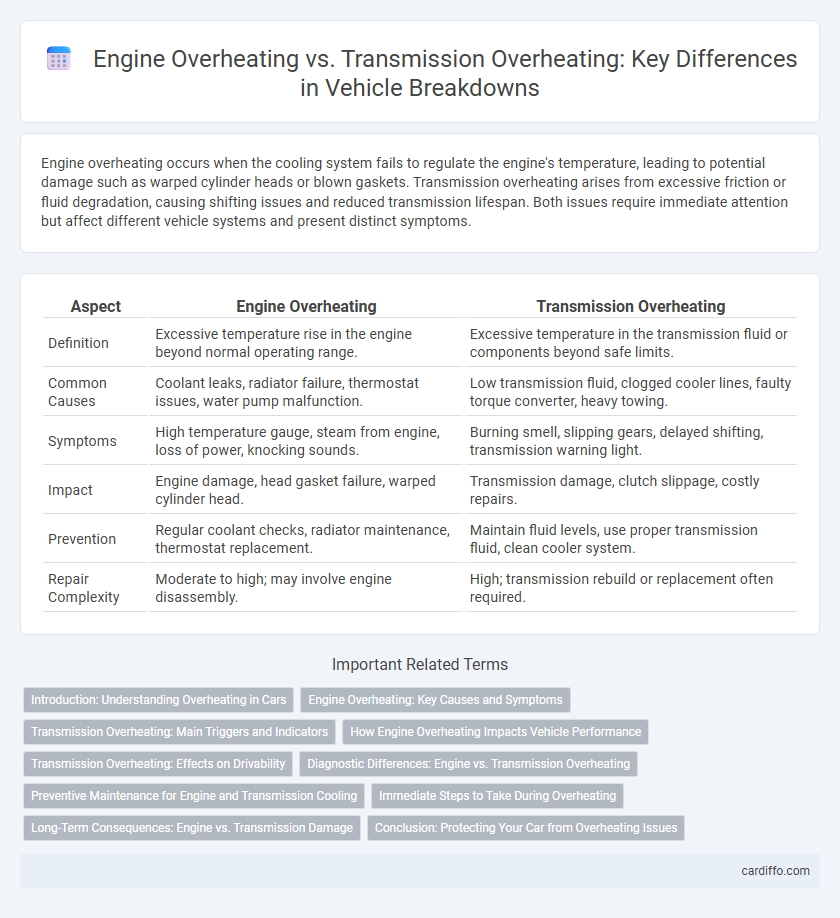Engine overheating occurs when the cooling system fails to regulate the engine's temperature, leading to potential damage such as warped cylinder heads or blown gaskets. Transmission overheating arises from excessive friction or fluid degradation, causing shifting issues and reduced transmission lifespan. Both issues require immediate attention but affect different vehicle systems and present distinct symptoms.
Table of Comparison
| Aspect | Engine Overheating | Transmission Overheating |
|---|---|---|
| Definition | Excessive temperature rise in the engine beyond normal operating range. | Excessive temperature in the transmission fluid or components beyond safe limits. |
| Common Causes | Coolant leaks, radiator failure, thermostat issues, water pump malfunction. | Low transmission fluid, clogged cooler lines, faulty torque converter, heavy towing. |
| Symptoms | High temperature gauge, steam from engine, loss of power, knocking sounds. | Burning smell, slipping gears, delayed shifting, transmission warning light. |
| Impact | Engine damage, head gasket failure, warped cylinder head. | Transmission damage, clutch slippage, costly repairs. |
| Prevention | Regular coolant checks, radiator maintenance, thermostat replacement. | Maintain fluid levels, use proper transmission fluid, clean cooler system. |
| Repair Complexity | Moderate to high; may involve engine disassembly. | High; transmission rebuild or replacement often required. |
Introduction: Understanding Overheating in Cars
Engine overheating occurs when the coolant system fails to regulate the engine temperature, leading to potential damage such as warped cylinders or blown head gaskets. Transmission overheating results from excessive friction and insufficient cooling within the transmission fluid, causing delayed shifting or complete transmission failure. Identifying specific symptoms like rising temperature gauges for the engine or slipping gears for the transmission is crucial for timely intervention and preventing costly repairs.
Engine Overheating: Key Causes and Symptoms
Engine overheating occurs when the cooling system fails to regulate the engine temperature, commonly due to low coolant levels, a malfunctioning thermostat, or a broken water pump. Key symptoms include a rising temperature gauge, steam emerging from the engine bay, and a burning smell. Ignoring these signs can lead to severe engine damage and costly repairs.
Transmission Overheating: Main Triggers and Indicators
Transmission overheating primarily occurs due to excessive towing, low transmission fluid levels, or clogged transmission coolers, which impede the system's ability to regulate temperature effectively. Key indicators include a burning smell, dark or burnt transmission fluid, and erratic shifting or slipping gears. Monitoring fluid temperature gauges and addressing early signs can prevent severe transmission damage and costly repairs.
How Engine Overheating Impacts Vehicle Performance
Engine overheating significantly reduces vehicle performance by causing the engine to run inefficiently, leading to power loss and potential engine damage. High temperatures can warp cylinder heads, damage gaskets, and result in coolant leaks, which further exacerbate overheating issues. Persistent engine overheating may trigger safety systems to limit engine power, forcing the vehicle into limp mode to prevent severe mechanical failure.
Transmission Overheating: Effects on Drivability
Transmission overheating significantly impairs drivability by causing erratic shifting, slipping gears, and reduced power transfer to the wheels. Excessive heat degrades transmission fluid, leading to inadequate lubrication and increased friction within internal components. Persistent overheating can result in costly repairs, including worn clutches and damaged torque converters, ultimately compromising vehicle performance and safety.
Diagnostic Differences: Engine vs. Transmission Overheating
Engine overheating typically presents with rising coolant temperatures and visible steam from the radiator, indicating issues like coolant leaks or a failing thermostat, whereas transmission overheating often involves a burning smell and erratic shifting due to degraded transmission fluid or internal friction. Diagnostic tools for engine overheating include checking coolant levels, radiator function, and thermostat operation, while transmission overheating diagnosis relies on assessing transmission fluid temperature, fluid quality, and hydraulic pressure. Identifying the specific overheating source is crucial for targeted repairs, as engine and transmission systems have distinct cooling mechanisms and symptom profiles.
Preventive Maintenance for Engine and Transmission Cooling
Regular preventive maintenance for engine and transmission cooling systems significantly reduces the risk of overheating breakdowns. Ensuring proper coolant levels, inspecting hoses and belts, and cleaning radiators optimize heat dissipation and prevent thermal damage. Scheduled flushing of cooling fluids and timely replacement of faulty thermostats maintain efficient temperature regulation for both engine and transmission components.
Immediate Steps to Take During Overheating
Engine overheating requires immediately stopping the vehicle to prevent severe damage to the cylinder head and gasket, allowing the engine to cool down before checking coolant levels or leaks. Transmission overheating demands pulling over safely to shift into neutral, avoiding heavy acceleration, and inspecting the transmission fluid for low levels or contamination to protect internal components. Both scenarios necessitate avoiding driving to prevent costly repairs and seeking professional mechanical assistance promptly.
Long-Term Consequences: Engine vs. Transmission Damage
Engine overheating often leads to severe long-term damage such as warped cylinder heads, blown head gaskets, and potential engine seizure, resulting in costly repairs or engine replacement. Transmission overheating primarily affects the transmission fluid's viscosity and internal components, causing premature wear, slipping gears, and eventual transmission failure if not addressed promptly. Understanding these consequences emphasizes the critical need for proper cooling system maintenance to prevent severe damage to both the engine and transmission.
Conclusion: Protecting Your Car from Overheating Issues
Engine overheating and transmission overheating both pose serious risks to vehicle performance and longevity, requiring distinct preventive measures. Regular maintenance, including coolant level checks for the engine and transmission fluid inspections for the transmission, is essential to prevent overheating damage. Investing in quality cooling systems and timely repairs ensures optimal temperature regulation, safeguarding your car from costly breakdowns.
Engine overheating vs transmission overheating Infographic

 cardiffo.com
cardiffo.com